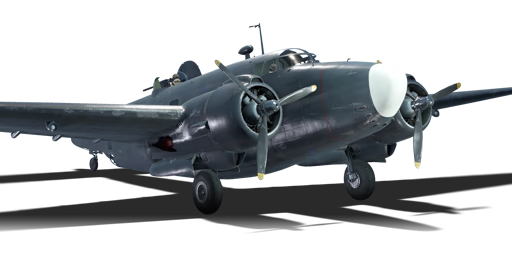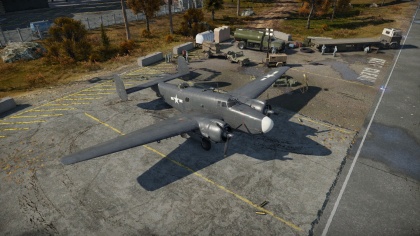PV-2D
Contents
| This page is about the aircraft PV-2D. For the standard version, see B-34 |
Description
The PV-2D Harpoon is a gift Rank III American medium bomber
with a battle rating of 4.3 (AB), 3.7 (RB), and 3.3 (SB). It was introduced in Update 1.67 "Assault", during the 2017 World War Two: Chronicle event, unlocked after obtaining 6 Chronicle Awards.
The PV-2D Harpoon is a bomber and should be played as such. Though its payload is not big enough to attack bases and airfield, it allows for enough power against tactical targets such as ground and naval units. The eight nose-mounted 12.7 mm machine guns also allow for great damage effect on light-skinned enemy vehicles, even enemy planes are able to align the rounds onto the target. Though the gunners provide ample top and bottom protection, the tail of the vehicle is a blind spot to the two turret gunners and thus a tailing pursuant would be a priority threat.
General info
Flight Performance
| Characteristics | |||||||
|---|---|---|---|---|---|---|---|
| Stock | |||||||
| Max Speed (km/h at 4,267 m) |
Max altitude (meters) |
Turn time (seconds) |
Rate of climb (meters/second) |
Take-off run (meters) | |||
| AB | RB | AB | RB | AB | RB | ||
| 488 | 435 | 9,500 | 29.9 | 30.3 | 7.2 | 8.8 | 549 |
| Upgraded | |||||||
| Max Speed (km/h at 4,267 m) |
Max altitude (meters) | Turn time (seconds) | Rate of climb (meters/second) |
Take-off run (meters) | |||
| AB | RB | AB | RB | AB | RB | ||
| 513 | 478 | 9,500 | 26.3 | 28.6 | 19.0 | 12.0 | 549 |
Details
| Features | ||||
|---|---|---|---|---|
| Combat flap | Take-off flap | Landing flap | Air brakes | Arrestor gear |
| ✓ | ✓ | ✓ | X | X |
| Limits | ||||
|---|---|---|---|---|
| Wing-break speed (km/h) |
Gear limit (km/h) |
Combat flap (km/h) |
Max Static G | |
| + | - | |||
| 0 | 277.8 | 340 | ~?? | ~? |
| Optimal velocities | |||
|---|---|---|---|
| Ailerons (km/h) |
Rudder (km/h) |
Elevators (km/h) |
Radiator (km/h) |
| < 260 | < 290 | < 320 | > 337 |
| Compressor (RB/SB) | ||
|---|---|---|
| Setting 1 | ||
| Optimal altitude | 100% Engine power | WEP Engine power |
| 1,615 m | 1,600 hp | 1,984 hp |
| Setting 2 | ||
| Optimal altitude | 100% Engine power | WEP Engine power |
| 4,023 m | 1,450 hp | 1,798 hp |
Survivability and armour
- 12 mm Steel - Armor plate cockpit, in front of the pilot
- 12 mm Steel - Armor plate cockpit, behind the pilot
- 12 mm Steel - Armor plate cockpit, behind radio operator/navigator
- 12 mm Steel - Armor plate - tail section, ventral gunner protection
- 12 mm Steel - Armor plate - dorsal gunner protective plate
Armaments
Offensive armament
The PV-2D is armed with:
- 8 × 12.7 mm Browning M2 machine gun, cheek-mounted (250 rpg = 2000 total) [AB Reload time: 20s]
Suspended armament
Main article: Bombs
The PV-2D can be outfitted with the following ordinance:
- 6 x 250 lb bombs (1,500 lb total)
- 8 x HVAR rockets
- 8 x HVAR rockets + 6 x 250 lb bombs (1,500 lb total)
- 8 x HVAR rockets + 1 x M13/44 torpedo
- 8 x HVAR rockets + 6 x 500 lb bombs (1,500 lb total)
- 8 x HVAR rockets + 6 x 1,000 lb bombs (6,000 lb total)
- 8 x HVAR rockets + 2 x Tiny Tim rockets
Defensive armament
The PV-2D is defended by:
- 2 x 12.7 mm Browning M2 machine gun, dorsal turret (400 rpg = 800 total)
- 2 × 12.7 mm Browning M2 machine gun, ventral turret (1,000 rpg = 2,000 total)
Usage in the battles
Manual Engine Control
| MEC elements | ||||||
|---|---|---|---|---|---|---|
| Mixer | Pitch | Radiator | Supercharger | Turbocharger | ||
| Oil | Water | Type | ||||
| Controllable | Not controllable | Not controllable | Not controllable | Separate | Not ontrollable | Not controllable |
Modules
| Tier | Flight performance | Survivability | Weaponry | |||
|---|---|---|---|---|---|---|
| I | Fuselage Repair | Radiator | Offensive 12 mm | FRC mk.5 | ||
| II | Compressor | Airframe | ITC mk.3 | |||
| III | Wings Repair | Engine | New 12 mm MGs | Turret 12 mm | SBC-17 | |
| IV | Engine Injection | Cover | New 12 mm MGs (turret) | LBC-25 | ||
Pros and cons
Pros:
- Very effective offensive armament; 8 x 12.7 mm Brownings: nose mounted
- Very strong airframe
- Effective defensive armament with good coverage over rear section of aircraft
- The dorsal turret can swivel 360 degrees and even fire at targets off the nose of the plane
- Can provide initial cover for other bombers until fighter escorts reach a bomber altitude
- Great top speed compared to other medium bombers
- Good climb rate
- Excellent payload capacity of bombs, rockets and torpedoes
Cons:
- Aircraft defensive blind spots include belly of aircraft
- Mediocre energy retention and manoeuvrability, due to heavyweight (with ordinance loaded)
- Offensive armament will only be useful in attacking enemy bombers, ground targets, or engaging fighters head-on
- Steel construction adds to the overall weight, leaving room for small payload; limited ability to be used as a tactical or strategic bomber
- Elevators easily shot off, can cause aircraft to become unstable, however, the aircraft can still be controlled operating flaps and/or adjusting engine power
History
Ventura
After the success of the Lockheed Hudson, Lockheed sought to introduce another bomber named the Ventura based off their Model 18 Lodestar transport aircraft. Though similar to the Hudson, the Ventura was a lot bigger. The Royal Air Force adopted the plane under the Ventura name, and the United States Army Air Force (USAAF) adopted it as the B-34 Lexington. Though the Ventura was faster and could hold twice as much bombs than the Hudson, the Royal Air Force did not like the plane very much and were replaced by Mosquitos, the surplus Venturas sent towards Coastal Command. America's usage of the B-34 Lexington was complicated with a feud in air power between the USAAF and the US Navy (USN). The USAAF had a monopolization on manufacturing and command of land-based bombers, leading to naval activities such as anti-submarine duties with bombers be shouldered by the USAAF rather than the USN, forcing the usage of float planes like the Catalina in the Navy's role. It wasn't until a compromise with the B-29 Superfortress in a naval manufacturing factory that the Army finally gave the Navy the aircraft and jurisdiction to act in their roles.
The Lockheed Ventura bomber, an aircraft the USN had an eye for, was converted for their usage. The adapted Venturas were adopted under the designation PV-1 Ventura for the navy, with special equipment for patrol bombing, increased fuel storage along with a decrease in forward defensive armaments, and the addition of search radar. The first PV-1s arrived in December 1942, then entered naval service in February 1943.
The PV-1 was an adequate bomber but provided some weaknesses needed addressing, most notably in that the increased fuel weight made it difficult to take-off without problems. The Ventura design was modified with an increased wing area in order to improve take-off and load-carrying capability. This allowed the aircraft to carry not only up to 4,000 lb of bombs but even rockets under the wings. The redesigned aircraft was accepted by the USN as the PV-2 Harpoon. More than 500 Harpoons were built in the course of the war, with several variants. The original PV-2 had five forward armaments whereas the PV-2D updated it with eight forward guns. The PV-2C and PV-2T models were models built for training.
Combat usage
The PV-1 was operated by three squadrons in the Pacific Theater and flew bombing strikes against Japan. The PV-1 usually accompanied B-24s due to having a more sophisticated radar system. A few were also given to the Marine Corps fighter squadron VMF(N)-531 at the Solomon Islands.
The PV-2's design had a shaky start, issues with the wings wrinkling came off as dangerously problematic. Another redesign was needed, delaying the introduction into the Navy until early 1945, with the ones already delivered converted for training purposes as the PV-2C. When the Harpoons were finally shipped, it went as the PV-2D model, and these aircraft designs proved reliable and popular with the crews that used them.
After the war, the Venturas and its variants were eventually declared obsolete. A number were scrapped, some were given away to foreign nations during and after the war. A number of the aircraft still survive today in both airworthy and display-only conditions.
Media
An excellent addition to the article will be video guides, as well as screenshots from the game and photos.
Read also
Obtainable events
- The PV-2D Harpoon was available in 2017 World War Two: Chronicle Event, unlocked after obtaining 6 Chronicle Awards.
- It was made available again during the 2018 WW2 Chronicles during the "Special Objectives" section of the event, where it could be assembled as a coupon with 12 Element piece and a scheme, with the latter obtainable after completing seven tasks in air battles and a community milestone of 400,000 completed Special Objectives is obtained.
Sources
Paste links to sources and external resources, such as:
- topic on the official game forum;
- page on aircraft encyclopedia;
- other literature.
| USA bombers | |
|---|---|
| Dive | SB2U-2 · SB2U-3 · SBD-3 · SB2C-1C · SB2C-4 |
| Torpedo | TBD-1 · PBY-5 Catalina · PBY-5A Catalina · TBF-1C · BTD-1 |
| Medium | B-10B · B-18A · B-34 · PV-2D · B-25J-1 · B-25J-20 · A-26C-45 · A-26C-45DT · B-26B |
| Heavy | B-17E · B-17E/L · B-17G-60-VE · PB4Y-2 · B-24D-25-CO · B-29A-BN |
| Hydroplanes | OS2U-1 · OS2U-3 · PBM-1 "Mariner" · PBM-3 "Mariner" · PBM-5A "Mariner" |





